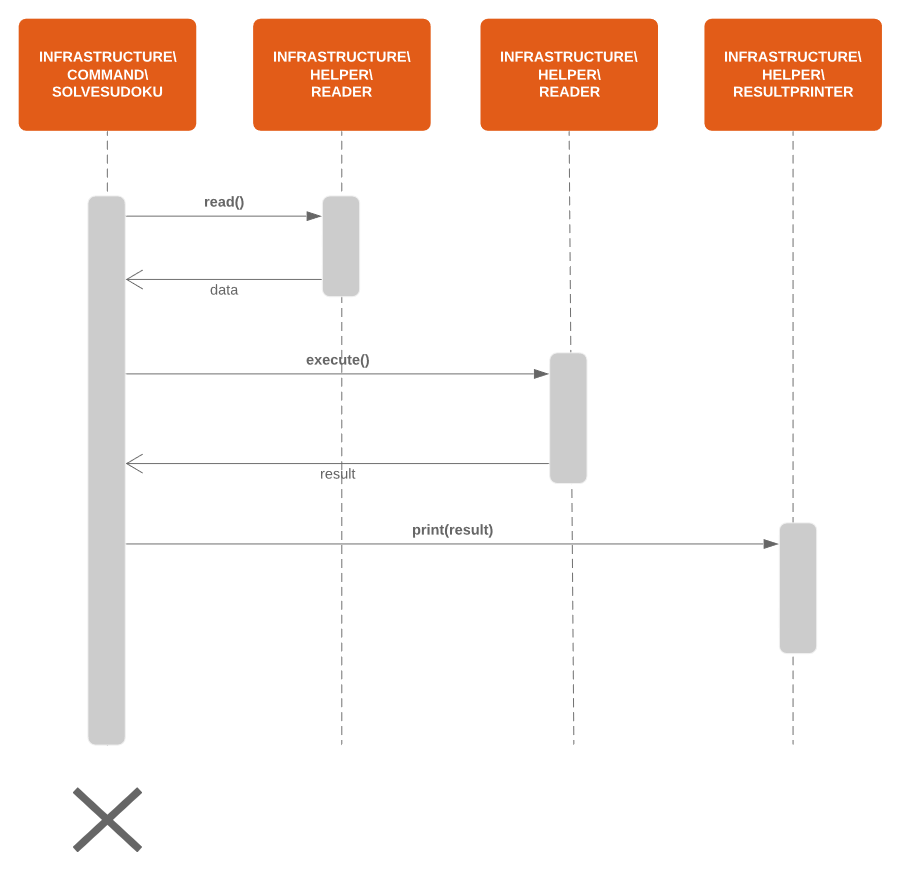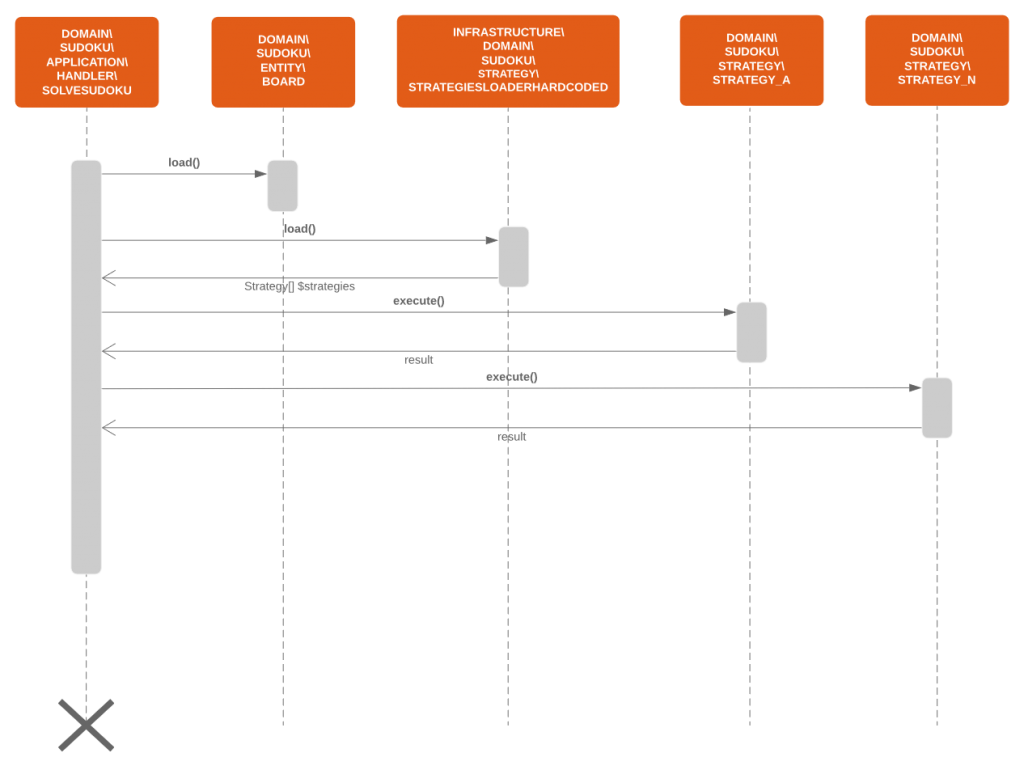I love to solve sudokus. Every cell must have the exact digit. If you are wrong, you fix a row but at the same time you break a column or a square (it happens the same when you deal with complex software systems, but this is another story…).
To solve them, I have gathered a set of tricks I can apply sistematically. It requires focus and discipline. But they usually let me get the work done.
One day, I wondered… Can I implement these tricks into an application? And I starting building in my mind the classes needed to implement a sudoku solver. And I came up with this implementation in PHP (you can find it in my github repository).
The classes
Structural classes

Structural classes for Sudoku solver app
- They are kept in the namespace
Domain\Sudoku\Entity. - Their responsibility is to keep the status of the sudoku while it is solved.
- You will find classes like
Board,Cell,ColumnorSquare.
Strategy classes
- They are kept in the namespace
Domain\Sudoku\Strategy\Strategy. - Their responsibility is to solve the sudoku.
- I have added a
Strategyclass for every trick I have implemented. - When the algorithm is too complex, I have splitted part of the strategy into a
Substrategyclass. - They are grouped into a collection, returned by a class implementing the interface
Domain\Sudoku\Strategy\StragiesLoader.
Use case classes
- They are kept in namespace
Domain\Sudoku\Application\Handler. - They are the entry point into the domain.
- There should be a class for each use case.
- There is one single class of this type so far:
SolveSudoku, responsible to orchestrate the solving of the provided sudoku.
Value object classes
- They are kept in
Domain\Sudoku\ValueObject. - You will find value objects like
Position,StatusorResult. - There is one special subtype of value objects in
Domain\Sudoku\ValueObject\CellContent. They are the different types of content a cell can have:Fixed,Found,NothingorTied. - There is another subtype
Domain\Sudoku\ValueObject\Event. These are the different events the application will publish.
The Tied class
What type of CellContent is Tied? It is vital to solve the sudoku.
A cell is tied when you know for sure it can only hold an specific set of digits (usually, 2 digits). Tied cells are coupled in a square (for example: cells 1 and 2 hold digits 8 and 9). You don’t know so far which cell holds which digit. But at least this information gives you a clue which digits cannot be found in this cells (in this example: 1,2,3,4,5,6,7) so they must be in another cells of the square.
My implementation only calculate level 2 of ties (that is, involving 2 digits and 2 cells). But perhaps I could refine it to calculate level 3 ties….
The Domain namespace
You will notice all these classes are into the same namespace Domain.
I have followed this guideline: all classes involved with the implementation of the solution are in this namespace.
It is the namespace where almost all the work is done.
The infrastructure namespace
The other main namespace is Infrastructure where I have the classes responsible of:
- Implementing the interface with the outer world (right now, the only interface is a command line application implemented by
Infrastructure\Command\Sudoku. - Implementing any interface needed by the domain (the only class of this type so far is
Infrastructure\Domain\Sudoky\Strategy\StrategiesLoaderHardcoded.
Command line version
So far, the only way to use this application is by its command line version (when I have some time, I will implement a REST API version…).
It is implemented in Infrastucture\Command\SolveSudoku. This is a Symfony command console:

- It will expect the following parameters:
- A file with the initial sudoku.
- A parameter
return_stepsto return the performed steps (apart from the solution). - A parameter
max_iterationsto setup how many iterations to try before giving up.
- It will setup the desired logging level (from optional argument –
v). - It will read the provided file and convert it into a valid array.
- It will call the use case class
Domain\Sudoku\Application\Handler\SolveSudoku. - It will convert the result of the command (optionally, including the steps) to json and will return it to the console.
The domain command handler workflow
Domain\Sudoku\Application\Handler\SolveSudokuwill receive the sudoku to solve (inside aDomain\Sudoku\Application\SolveSudokupayload, built and passed by the infrastructure).SolveSudokuwill build aDomain\Sudoku\Entity\Boardobject with the data.SolveSudokuwill use the injectedDomain\Strategy\StrategiesLoaderto load the differentDomain\Sudoku\Strategy\Strategyclasses.SolveSudokuwill start applying the loaded strategies to the board up until:- The sudoku is solved.
- The max number of iterations is reached.
- The sudoku is in a wrong status.
The strategies
For every trick I can apply to solve a sudoku, I have implemented one strategy. They are on Domain\Sudoku\Application\Strategy\Strategy.
If the strategy is too complex to phpunit it, I have sometimes splitted part of it into a class (in the subfolder Substrategy).
I don’t have a definite option to load all these strategies into the SolveSudoku command handler:
- I may use a Symfony configuration.
- Or perhaps a folder scanner.
This is the reason I am using an interface Domain\Sudoku\Strategy\StrategiesLoader to delay my decision.
So far, I have implemented it returning a hardcoded array of strategies. It is in class Infrastructure\Domain\Sudoku\Strategy\StrategiesLoaderHardcoded.
Conclusions?
For me, the most important part is not the result but the journey itself. It is nice to work without any deadlines so you have room to discover new behaviours and refactor whatever you need.
This post is getting too long. So I have skipped explaining some details. Like event managing, logging and exception handling. I have written another post about it.
In the future, I would like to test it more thoroughly (more complex sudokus) and implement some pending strategies (they are a bit more difficult to code, I am afraid).
I would also like to implement a REST API. Even a javascript front end.
I hope you have enjoyed it as much as I did.







